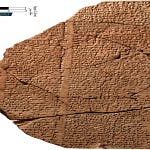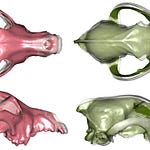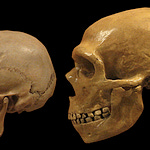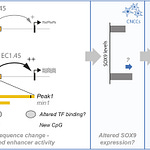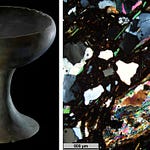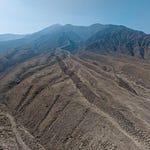In the shallow seafloor of Indonesia's Madura Strait, just off the coast of Java, an ancient landscape long hidden beneath the waves is beginning to come into focus. Through a combination of dredging operations, geological analysis, and fossil discovery, researchers have reconstructed a prehistoric river valley that once carried the Solo River eastward across what is now submerged Sundaland. And with it, they’ve uncovered an unexpected chapter in the life of Homo erectus1.
A River Runs Through It
The Solo River has long been central to the story of Homo erectus in Southeast Asia. From the classic sites of Trinil and Ngandong, where early skullcaps reshaped our understanding of human origins, to the middle Pleistocene terraces that mark the species' last known traces, this river has yielded critical clues to our evolutionary past. But a new study, led by H.W.K. Berghuis and colleagues, shifts attention downstream—into the seabed itself.
In 2014–2015, dredging crews working to reclaim land near Surabaya extracted over 5 million cubic meters of sediment from the Madura Strait. What they found embedded in the sands stunned researchers: thousands of vertebrate fossils, including the skull fragments of Homo erectus. These remains represent the first direct evidence of Pleistocene hominin activity in submerged Sundaland.
“The fossils provide a rare and unprecedented insight into the Pleistocene vertebrate fauna of submerged Sundaland,” the authors wrote.
Careful geological analysis revealed that these fossils were embedded within a fluvial sediment sequence, part of a sand-filled paleovalley carved into marine clays. This valley was dated using optically stimulated luminescence (OSL) techniques to between 162,000 and 119,000 years ago—placing it squarely in the Marine Isotope Stage 6 (MIS6) glacial period, when sea levels were dramatically lower.
Fossils in a Drowned Landscape
The paleovalley fill preserves a complex transition: from terrestrial river sediments at its base to estuarine sandstones at its top, deposited as rising seas inundated the valley. This geological layering mirrors other known Homo erectus contexts on Java, but in this case, the fossiliferous layers lie underwater. What makes the discovery especially compelling is its temporal overlap with the Homo erectus fossils from Ngandong, previously considered the species' youngest population.
The sedimentological and faunal evidence suggests that this coastal lowland—at the time a vast grassland traversed by meandering rivers—was not only habitable but actively occupied by hominins. Among the fossil assemblage were bones bearing cut marks, evidence of butchery, and a suite of extinct and extant fauna, from water turtles to bovids.
“This earliest incisive stage of the Solo... is probably the equivalent of the lowest, partly preserved paleovalley of the Madura Strait north of Surabaya,” the team wrote, tying the submerged valley to broader patterns of fluvial incision during glacial periods.
Connecting Ngandong to the Coast
Berghuis and his co-authors draw a compelling link between the Madura Strait site and the better-known inland terraces of the Solo River. Both appear to have undergone similar cycles of incision and aggradation driven by glacial-interglacial sea-level fluctuations. The study suggests that during MIS6, the Solo River extended well beyond its present mouth, cutting across now-drowned plains to empty into a much more distant sea.
That coastal zone, rich in resources and ecological diversity, would have offered opportunities for Homo erectus populations to thrive. The river system connected upland and lowland environments, potentially serving as a corridor for dispersal—and perhaps, for interaction with other archaic hominins.
“The valley was probably cut during the preceding stage of falling sea level, in the run-up to the lowstand of MIS6,” the authors explain, anchoring their dating to a precise climatic moment.
Rethinking Isolation
One of the long-standing views in paleoanthropology has been that Homo erectus in Java persisted in isolation, marooned by rising seas. The Madura Strait discoveries challenge that assumption. They show Homo erectus was not only present in coastal environments during the late Middle Pleistocene but possibly adapted to a dynamic, shifting landscape shaped by repeated sea-level change.
Moreover, the rich bone assemblages suggest active subsistence behaviors more complex than once thought. Researchers documented signs of marrow extraction from bovids, a pattern more typically associated with later hominins. Whether these practices reflect independent innovation or contact with other groups remains an open question.
Toward a Submerged Prehistory
The drowned shelf of Sundaland has long been considered archaeologically silent. This research offers a new direction—both literally and conceptually. The ancient river valley now submerged under 30 meters of seawater might be one of many such features preserving vital chapters of hominin prehistory.
“This makes our discoveries truly unique,” Berghuis remarked in a related interview. “The fossils come from a drowned river valley, which filled up over time with river sand.”
As geologists and archaeologists continue to collaborate, sediment by sediment, we may find that the missing pieces of Southeast Asia’s human story lie offshore, in landscapes carved by ancient rivers and drowned by time.
Related Research
Rizal, Y., Westaway, K. E., Zaim, Y., van den Bergh, G. D., et al. (2020). Last appearance of Homo erectus at Ngandong, Java, 117,000–108,000 years ago. Nature, 577(7792), 381–385. https://doi.org/10.1038/s41586-019-1863-2
Joordens, J. C. A., et al. (2015). Homo erectus at Trinil on Java used shells for tool production and engraving. Nature, 518, 228–231. https://doi.org/10.1038/nature13962
Louys, J., & Kealy, S. (2024). Faunal corridors and hominin dispersal routes in Pleistocene Sundaland. Quaternary Science Reviews, 318, 107171. https://doi.org/10.1016/j.quascirev.2023.107171
Hilgen, F. J., et al. (2023). Age constraints on the Trinil H. erectus fossils and the implication for hominin evolution in Southeast Asia. Science Advances, 9(2), eadd3147. https://doi.org/10.1126/sciadv.add3147
Brasseur, B., et al. (2011). Geochemical weathering patterns in the Pleistocene clays of eastern Java. Sedimentary Geology, 239(1–2), 51–66. https://doi.org/10.1016/j.sedgeo.2011.05.002
Berghuis, H. W. K., Veldkamp, A., Adhityatama, S., Reimann, T., Versendaal, A., Kurniawan, I., Pop, E., van Kolfschoten, T., & Joordens, J. C. A. (2025). A late Middle Pleistocene lowstand valley of the Solo River on the Madura Strait seabed, geology and age of the first hominin locality of submerged Sundaland. Quaternary Environments and Humans, 100042, 100042. https://doi.org/10.1016/j.qeh.2024.100042




